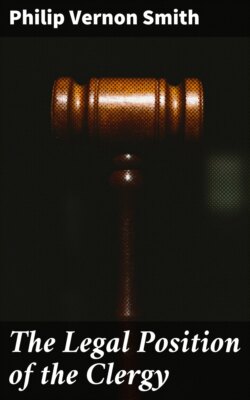Читать книгу The Legal Position of the Clergy - Philip Vernon Smith - Страница 11
На сайте Литреса книга снята с продажи.
Оглавление5. The legal position of the parochial clergy depends for its ultimate origin upon the legal status of the ancient Parish. The word is the English form of the Greek παροικία (habitation), and the Latin parochia, an expression originally synonymous with diocese (Gr. διοίκησις, i.e. administration; Lat. diœcesis, used of a district or part of a province in the Roman Empire), and applied to the territory assigned to the jurisdiction of a bishop, which was served by him and a college of clergy under him. But under Archbishop Theodore (668–690) or shortly after his time the process was begun of encouraging the lords of manors and great landowners to build churches for themselves and their dependants, and devote the tithes of their manors or estates to the maintenance of divine worship in these churches, and the performance of religious duties among the residents on the estates. This process was gradually extended throughout the country, and, wherever it was adopted, the tithes were assigned either to the priest for the time being in charge of the church, who was in that case called the rector (governor of the church) or parson (Lat. persona)[5] or to a monastery, the members of which were then expected to serve the church. The manor or estate, including any detached and outlying portions, became the parish of the church, and developed into a territorial unit not only for ecclesiastical but also for many civil purposes. Where the church was served by a single rector, the landowner who had endowed it and his successors after him were given in return the right of nominating to the bishop a clerk in Holy Orders to become rector of the church, or, in other words, they acquired the patronage or advowson[6] of the benefice. The frequent cases of neglect in the service of the parish, where a monastery was rector, led, in the thirteenth century, to the requirement that in such cases a succession of individual priests should be appointed to discharge the duty, with a definite portion of the endowments of the benefice as their stipend for so doing. As a rule the great tithes, being those of corn, grain, hay, and wood, were reserved to the monastery, and were in consequence styled rectorial tithes, while the officiating priest, who was styled a vicar, was endowed with the remaining or small tithes, which consequently were called vicarial. But in a few instances the officiating priest, instead of becoming entitled to the small tithes, only received a fixed monetary stipend. Where this occurred, he was called a perpetual curate. It was the rule that rectories, whether in the hands of a monastery or a succession of individual priests, should be endowed not only with the tithes of the parish, but also with a house and lands, which are called glebe; and sometimes these houses and lands, or a part of the lands, were assigned towards the stipend of the vicar.
